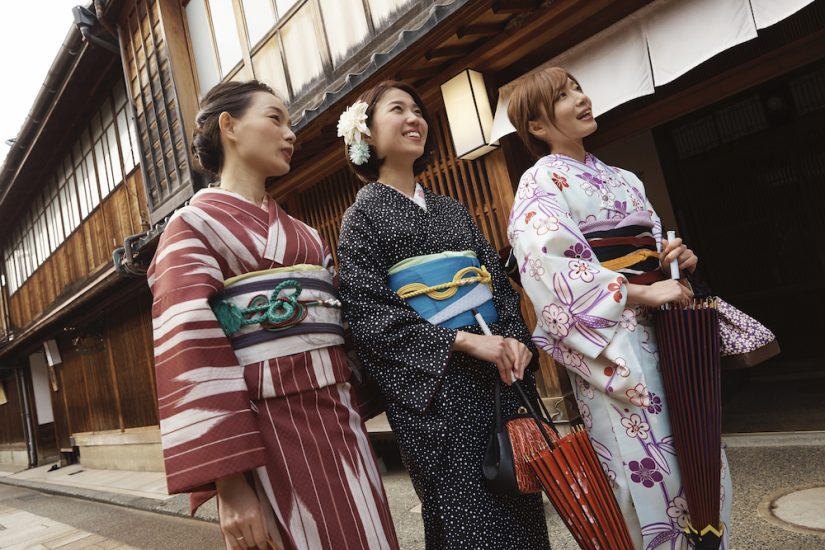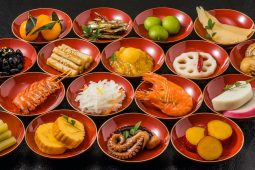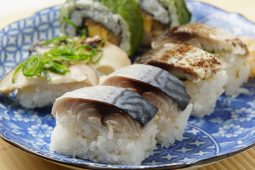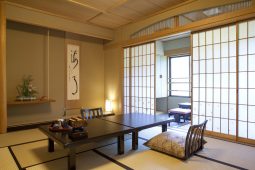Dressing up in traditional Japanese clothing can be a lot of fun, and recently renting kimono while sightseeing is very popular. In Japan, traditional clothes are called 和服 (wafuku which literally means “Japanese clothes”), to distinguish them from 洋服 (yōfuku or “Western clothes”). However, there are many different kinds of wafuku, so in this article we will look at the main kinds of clothes that you are likely to wear if you live in Japan. As you will see, there are distinct clothes for men and women, for formal and casual wear, and for different occasions and seasons.
Kimono (着物)
For many people the kimono represents Japan’s national costume, and is a symbol of elegance and grace. Literally, however, “kimono” simply means “something to wear”, a vague term that covers a lot of variety. As a general rule, women’s kimono tend to have very bright and colorful seasonal designs, while men’s kimono tend to have plainer designs and darker colors. Below are some common kimono types:
- Furisode (振袖) are long-sleeved kimono worn by young single women for formal occasions such as weddings, or the Coming of Age ceremony when they turn 20. Furisode are made of silk and have very bright, colorful designs.
- Hōmongi (訪問着) are semi-formal kimono suitable for both single and married ladies and are likely to be worn to a tea ceremony or a friend’s wedding.
- Komon (小紋) are more casual kimono for ladies with a finely detailed repeated pattern. They come in a great variety of designs and colors and are suitable for wearing around town. If you rent a kimono while sightseeing it is likely to be a komon.
- Men’s kimono tend to have less variety than those for ladies. For formal occasions men will wear a kimono with a hakama skirt and haori jacket. Dressing in a kimono without a hakama is more casual and called kinagashi (着流し). However, for men the level of formality is basically decided by the grade of material used, such as fine silk for formal occasions, and lower-grade tsumugi silk (sometimes called pongee) for less formal occasions.
Kimono Accessories
Below are listed some of the main accessories for kimono:
- Obi (帯) is a kind of belt or sash for a kimono. There are many kinds and patterns, but women’s obi are wider and men’s are much narrower and simpler in design.
- Nagajuban (長襦袢) is a long undergarment for ladies and men which is worn under the kimono. They are usually brightly decorated because they are visible at the collar and the sleeves of the outer garment. Though men’s kimono are quite plain, their nagajuban can add a dash of color to the outfit.
- Kanzashi (簪) are ornate hairpins used for ladies’ traditional hairstyles.
- Hakama (袴) are a kind of long pleated skirt worn by men or women over a kimono. Men wear hakama to formal occasions, while women might wear hakama if they take part in martial arts such as kyūdo, or kendo, or for university graduation ceremonies.
- Haori (羽織) is a jacket worn over kimono by men and women.
- Tabi (足袋) are split-toed socks worn with zōri or geta sandals.
- Zōri (草履) are thonged sandals often made with leather, cloth, or vinyl, and which should be worn with tabi socks.
- Geta (下駄) are wooden sandals which can be worn with or without tabi socks.
Kimono Alternatives
- Yukata (浴衣) are light, casual kimono for men and women, usually made of cotton and worn in the summer or as loungewear. You are likely to wear yukata if you go to a Japanese summer festival or fireworks display. If you visit a traditional hotel or hot spring resort, your hotel will probably supply yukata to wear around the premises.
- Jinbei (甚平) are the most casual (and most comfortable) wafuku. Similar in form to Western pajamas, they consist of a matching top and shorts made from linen or cotton. Mainly a form of loungewear to be worn around the home, they are also often worn to summer festivals by men and children. Recently young women also wear brightly colored jinbei to summer festivals.








